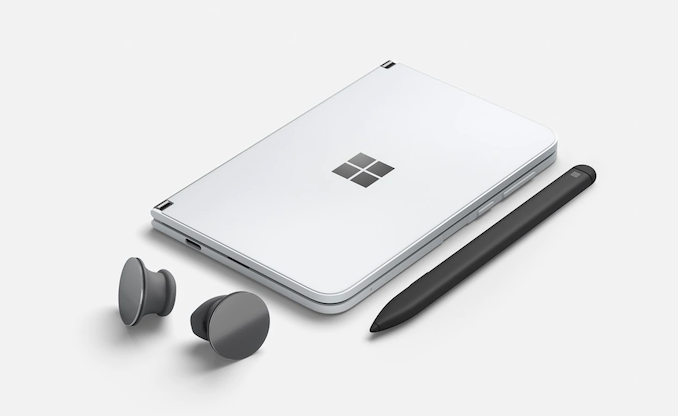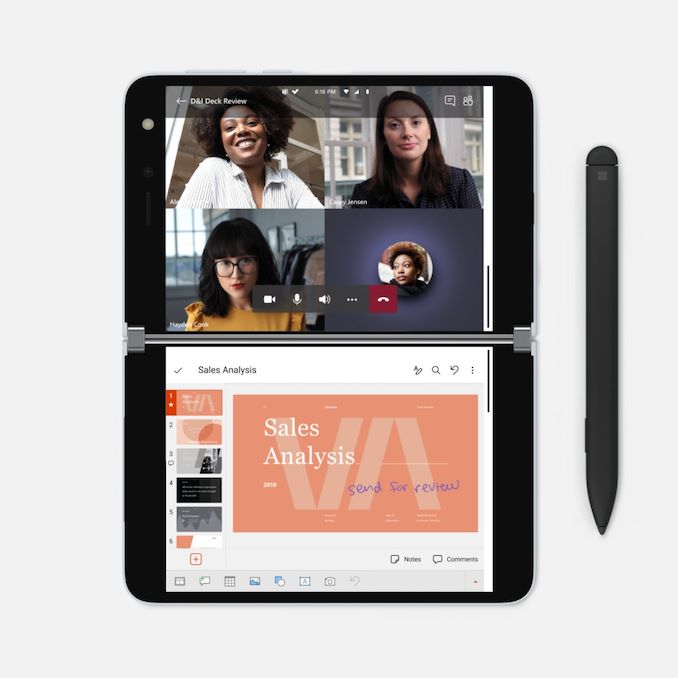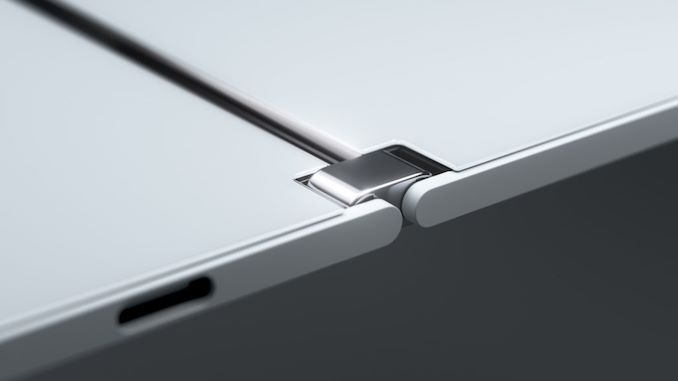Microsoft Opens Pre-Orders for Surface Duo - US Only
by Andrei Frumusanu on August 12, 2020 10:30 AM EST
Late last year in October, Microsoft had announced the Surface Duo, the company’s first ever Android device and first-party smartphone (if you can call it that) release in years. What makes the Surface Duo special is its symmetric dual-screen nature and 360° hinge mechanism that allows the device to fold itself shut like a book – to fully opening itself up with two opposing displays. Today Microsoft is finally making the Surface Duo available for pre-order – although availability will be limited to the US.
| Microsoft Surface Duo | ||
| Surface Duo | ||
| SoC | Qualcomm Snapdragon 855 1x Kryo 485 (Cortex-A76) @ 2.84GHz 3x Kryo 485 (Cortex-A76) @ 2.42GHz 4x Kryo 485 (Cortex-A55) @ 1.80GHz Adreno 640 @ 585MHz |
|
| DRAM | 6GB LPDDR4X | |
| Display | Dual 5.6" solid OLED with 360° hinge 1800 x 1350 (4:3) Unfolded 8.1" effective diagonal at 2700x1800 (3:2) |
|
| Size | Height | 145.2 mm |
| Width | 93.3 mm (closed) - 186.9 mm (open) | |
| Depth | 9.9mm (closed) - 4.8 mm (open) | |
| Weight | 250 grams | |
| Battery Capacity | 3577mAh total (dual cells) | |
| Wireless Charging | - | |
| Rear Cameras | ||
| Main | 11MP 1.0 µm f/2.0 |
|
| Telephoto | - | |
| Wide | - | |
| Extra | - | |
| Front Camera | - | |
| Storage | 128 / 256 GB UFS 3.0 | |
| I/O | USB-C | |
| Wireless (local) | 802.11ac Wave 2 Wi-Fi Bluetooth 5.0 LE + NFC |
|
| Cellular | (Category 12/5) DL = 1200Mbps 5x20MHz CA, 256-QAM UL = 150Mbps 2x20MHz CA, 64-QAM |
|
| Other Features | It folds | |
| Dual-SIM | 1x nanoSIM + eSIM | |
| Launch Price | $1399 | |
Starting off with the uninteresting stuff – the internal hardware of the Surface Duo isn’t all that exciting as it features a last generation Snapdragon 855 SoC. Given the device’s early announcement last year it seems Microsoft took a long time to bring the device to market. We’re seeing a standard amount of DRAM and storage space with 6GB and either 128GB or 256GB options. All in all there’s nothing too special about the internals here and are in line with 2019 flagships.
The device’s key characteristic is naturally its symmetrical folding design with two 5.6” 1800 x 1350 resolution OLED screens. Although we call this a folding device, this doesn’t actually apply to the displays as they’re two distinct units covered with solid glass.
Further unique to the design is the hinge mechanism which is symmetrical as well – it allows for a full 360° tilt of the two sides, meaning you can have the device either fully shut, or you can have it fully opened with both screen facing outwards.
Microsoft opted for relatively unusual form-factors here as the screens are each 4:3 – and when opened up it gives you a sort of effective 8.1” diagonal 3:2 surface to work with.
The dimensions of the device come at 145.2mm height in portrait mode, and one side is 93.3mm wide, which opens up till 186.9mm. Each half is extremely thin at only 4.8mm meaning that even when folded it remains a relatively reasonable 9.9mm in thickness.
The device’s 360° folding nature means that the internal screen surface can face completely outwards, and Microsoft took advantage of this for their camera design, of which the Surface Duo only has a single unit. The 11MP 1µm pixel f/2.0 standard wide-angle unit is relatively conservative in specifications, but that’s the compromise that had to be made to fit into a 4.8mm thick chassis and not having the possibility to employ a camera bump.
Microsoft positions the Surface Duo as a productivity device, and its first-party applications such as the Microsoft 365 suite will be optimised for the experience. This seemingly will be the deciding factor as to how the Surface Duo will be received, as it represents quite a niche device market.
The Surface Duo is available for pre-order now at a very high price of $1399, with availability only in the US and compatibility with AT&T, T-Mobile and Verizon, with availability starting September 10th.
The device’s high price and relatively lacklustre specifications will likely result in limited adoption amongst users- and the device in general feels more like an experiment than a product that’s aimed at commercial success.













71 Comments
View All Comments
vol.2 - Wednesday, August 12, 2020 - link
I think that it would annoy me too much. Every time I went to watch a movie or view a photo, I would look at the two screens and curse the fact they were totally separate and that I only had half the usable screen real estate of the whole device. I'd rather have a nice little hardware keyboard occupying that space.nico_mach - Wednesday, August 12, 2020 - link
But you can watch a movie while checking the scores, you can set it up in 'tent mode' to watch a movie or take a time picture, you can finally make sense of split screen mode, you can do an action game with touch controls off the main screen.It's certainly not for everyone though.
sonny73n - Thursday, August 13, 2020 - link
Lame!eek2121 - Wednesday, August 12, 2020 - link
This is a compelling product, just not for the use case most people think. I could see myself carrying this around in addition to my phone.ikjadoon - Wednesday, August 12, 2020 - link
If I want a portable productivity device, I'm not buying an 8" Android phablet. Extra-hard no if it costs me $1399.PeachNCream - Thursday, August 13, 2020 - link
I don't think I would want to carry an Android phone and then a Surface Duo because of the redundancy of the two and the limited additional capabilities the Duo currently appears to offer. Were it a Windows-based laptop in a similar size with a small, but tap-friendly keyboard then maybe it would be a little more compelling from the perspective of giving me different capabilities than I already have in a phone. Something like one of those GPD Micro PCs would be very much worth keeping track of an additional device.Granted that's a personal opinion and I don't have a clear sense of what else a Duo might be used for aside from overlapping with any other Android phone or tablet. Someone else would most certainly argue there is a use case for it and if that works for them, then they should go for it if their budget permits the purchase. I'll stick to using a 11.6 inch screen laptop and my existing phone for the time being.
ikjadoon - Wednesday, August 12, 2020 - link
Microsoft, asking $1399: "We love multitasking so much, we'll power two high-resolution screens with an SoC released in late 2018".Microsoft has easily become Hooli of our time: overpriced, corporate-tier, half-baked hardware backed by a congealed mass of disconnected, software.
And people thought Panos Panay was going to save Windows & Devices. 😂
nico_mach - Wednesday, August 12, 2020 - link
I don't think a SOC from 2018 is the problem you think it is. Then again, I'm still using an s8 very happily. It's the price that makes that CPU look bad.julianb - Friday, August 14, 2020 - link
Agreed. SD855 is still a very capable CPU. 20-25% less powerful then 865 but I don't think that would lead to any lag using the phone. People hear last gen CPU and they dismiss it automatically ignoring the much more important thing- it's a foldable phone which (hopefully) will be done right in terms of hardware and UI experience.I just hope that it will follow the success of Surface line and won't get canned for some random reason. So many large companies have done that.
shabby - Wednesday, August 12, 2020 - link
Those aren't high resolution screens at all, combined the screens only have 12% more pixels than the galaxy s10 which used the same soc. The gpu is more than adequate to drive more screens, the battery on the other hand... good luck lol